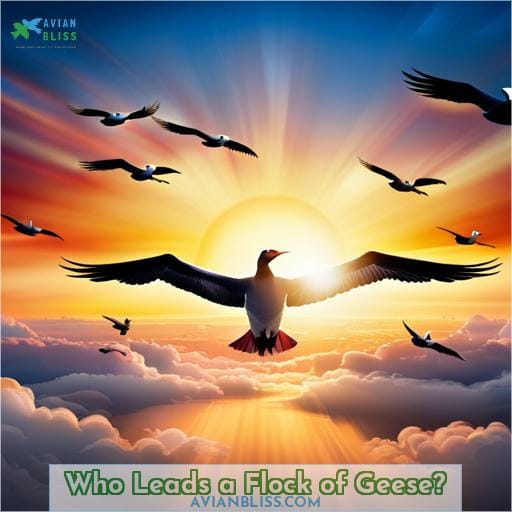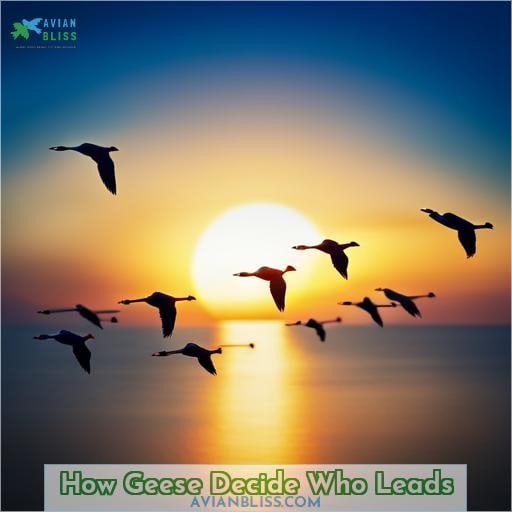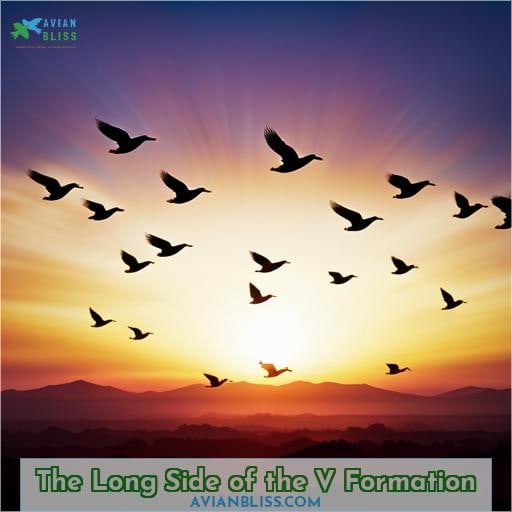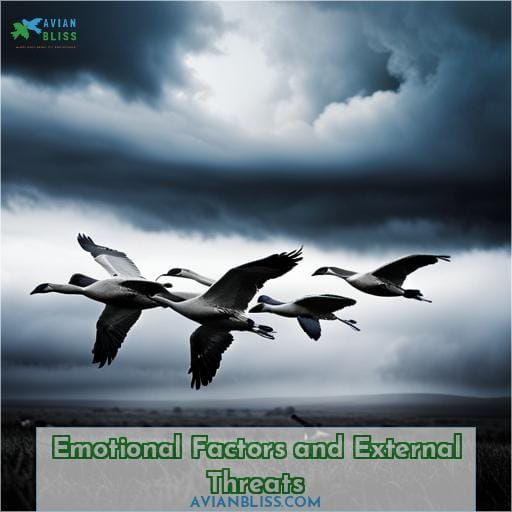This site is supported by our readers. We may earn a commission, at no cost to you, if you purchase through links.

The focal point of this article is the enigmatic question: how do geese decide who leads? The V formation they elegantly maintain during migration is not merely a show of unity but a living example of collective leadership.
Delve into the intricate patterns of avian cooperation, where each goose takes its turn at the helm, distributing the weight of leadership and guiding the flock towards their common goal.
Through the lens of these remarkable creatures, you’ll uncover valuable insights into cooperative decision-making, demonstrating the boundless potential of unified endeavors.
Table Of Contents
- Key Takeaways
- Who Leads a Flock of Geese?
- The Benefits of Flying in V Formation
- Shared Leadership and the Role of Each Goose
- How Geese Decide Who Leads
- The Long Side of the V Formation
- Geese Mating Patterns and Leadership
- Emotional Factors and External Threats
- Frequently Asked Questions (FAQs)
- Sure, here are 5 frequently asked questions that would not normally be answered in the provided article sections:
- How do geese communicate their readiness to switch leadership roles during flight?**
- What are some specific body language cues that geese use to coordinate their movements within the V formation?**
- Do geese exhibit any variations in migratory routes based on factors other than daylight length?**
- Are there any instances where geese might deviate from their typical V formation due to environmental conditions?**
- Can you provide examples of the types of emotional displays geese exhibit when mourning lost companions or showing affection?**
- Conclusion
Key Takeaways
- Geese exhibit leadership dynamics through V-formation flight.
- Leadership in geese is a shared responsibility, not a static badge.
- Flight adaptations and communication patterns define their leadership.
- Leadership rotation ensures distributed power and maintains efficiency.
Who Leads a Flock of Geese?
Amidst their synchronized journey through boundless skies, a seamless dance of leadership unfolds as the collective energy of the V formation orchestrates a harmonious exchange of roles.
Within the geese community, leadership isn’t a stationary badge; it’s a dynamic symphony of shared responsibilities. The lead position isn’t monopolized by a single bird with brute strength or charisma.
Instead, geese display a nuanced understanding of flight adaptations and communication patterns. They harmonize their flight, utilizing the aerodynamic benefits of the V formation while communicating through honks and subtle cues.
This dynamic interaction enables a smooth transition of leadership, as each member takes turns at the helm, recognizing the value of distributed power. This natural leadership ballet signifies a profound grasp of emotional influences and flight efficiency—a testament to their collective wisdom that we, too, might learn from.
The Benefits of Flying in V Formation
Sure, here’s a paragraph introducing the benefits of flying in a V formation for geese:
Undoubtedly, the formation that geese adopt during flight holds more than mere visual intrigue; it’s a masterstroke of aerodynamic finesse and efficient coordination. As they carve through the air in their iconic V formation, geese harness the power of vortices to bolster their flight, making it an exemplar of nature’s ingenuity.
This formation not only reduces individual energy expenditure but also serves as a conduit for seamless communication and impeccable synchronization among these avian navigators, affirming that there’s a science to their strategic unity.
Aerodynamic Boost
In the realm of avian aerodynamics, the synergy of the V formation lies in its unparalleled capacity to optimize flight efficiency, a feat accomplished through precise wingmanship and calculated positioning.
- Aerodynamic Efficiency: The V formation significantly reduces air resistance for trailing geese, boosting their efficiency.
- Wing Feathers: Feathers on wing edges provide vital insights into airflow, aiding in rapid adjustments.
- Wind Direction: The formation adapts to the wind direction, ensuring a consistent aerodynamic advantage.
- Leadership Rotation: Sharing the load through leadership rotation maintains team efficiency, as every goose takes its turn at the helm.
Communication and Coordination
Embracing a finely tuned system of honks, body language, and subtle feather adjustments, your fellow flyers harmoniously coordinate their movements, ensuring seamless communication and unity within the team during their migratory journey.
Communication Dynamics:
Geese honk to signal direction changes and coordinate movements. Varied honk sequences convey different messages within the flock.
Coordinated Movements:
Geese adjust positions swiftly, adapting to changing air currents, maintaining formation. Feather adjustments provide real-time info on air currents, aiding flight coordination.
Unity Building:
Regular communication and progress celebration foster a sense of unity and common purpose. Shared responsibility cultivates leadership qualities in each goose and strengthens unity.
Support:
Weaker geese receive assistance and protection from their companions, reinforcing solidarity.
The symphony of honks and orchestrated movements showcases their remarkable ability to function as a synchronized team, encouraging progress and reinforcing unity while pursuing their shared migratory objective.
Shared Leadership and the Role of Each Goose
Steering the flight of a flock of geese isn’t solely the responsibility of one feathered leader, but rather a dynamic dance of shared leadership and collective effort. As these birds take to the skies in their iconic V formation, each goose plays a vital role in sharing the load and taking turns at the helm, ensuring a harmonious synergy that propels the team forward with both grace and efficiency.
Sharing the Load
Navigating the skies together, each member of the flock takes its turn at the forefront, sharing the load and carving a path forward.
As geese engage in this graceful dance of shared leadership, profound benefits unfold:
Benefits of Rotation: The fluid rotation of leaders prevents burnout, fostering a sense of empowerment within the team.
Teamwork Dynamics: This cyclic sharing of responsibility nurtures unity and equal contribution, amplifying the strength of the entire flock.
Energy Conservation: Alternating leaders conserve energy, allowing for sustained endurance during their arduous journeys.
Communication Strategies: Regular changes in leadership encourage dynamic communication strategies, adapting to various challenges on their migration route.
Taking Turns Leading
Experience the dynamic synergy of this collaborative avian squadron as each winged member seamlessly transitions into the lead position, exemplifying their harmonious rotational leadership approach. Leadership dynamics are based on shared responsibility and mutual respect. Geese shift leaders for optimal energy conservation, ensuring the team’s endurance.
Their communication strategies, such as honking and body language, aid in seamless transitions. This rotational hierarchy strengthens teamwork benefits, reflecting in successful goals, rearing young, and consistent mating patterns.
How Geese Decide Who Leads
Diving into the mechanisms behind geese leadership, early research unveils an intricate decision-making process rooted in both efficiency and adaptation. From their vantage point within the dynamic V formation, geese employ keen observation and instantaneous adjustments to seamlessly determine who leads, revealing a finely tuned balance between instinctual cues and environmental cues.
Early Research
Taking turns like a synchronized dance, each winged partner in the sky’s choreography subtly asserts its moment in the spotlight. Early research into geese’s leadership dynamics reveals intriguing insights into their decision mechanisms and formation evolution.
Behavioral studies unveil a fascinating interplay of cues and signals that guide their rotation. Research perspectives indicate that this intricate system has evolved to ensure efficiency and unity, reflecting the intricate balance of power within the flock.
Research Perspectives on Geese’s Leadership:
- Communication Patterns: Vocalizations, wing movements, and body language shape leadership transitions.
- Visual Cues: Feathers’ alignment aids in recognizing readiness for leadership.
- Coordination Dynamics: Geese synchronize actions, minimizing disruptions during shifts.
- Adaptive Evolution: Decision mechanisms have developed to adapt to changing environments.
- Energy Conservation: Leadership shifts minimize individual strain while maintaining group cohesion.
In this complex tapestry of decision-making, formation evolution, and behavioral insights, geese offer a unique lens through which to understand leadership dynamics in nature, mirroring our subconscious desire for liberation, power, and understanding.
Vantage Point
From this vantage point, you gain a clear view of how this dynamic unfolds, igniting a sense of wonder about nature’s intricate symphony. Vantage insights reveal that geese’s leadership isn’t a solitary endeavor; it’s a fluid symposium of cooperation.
Formation dynamics underscore their agility. Energy distribution shifts as each goose takes its turn at the helm, balancing effort. Navigation strategies intertwine with communication, as wing adjustments relay vital cues.
The Long Side of the V Formation
Amidst the sky’s choreography, one position in the V formation extends gracefully, catching the subtle currents and wind’s embrace, offering a symphony of lift and unity in the avian dance.
This extended side, influenced by the direction of the wind, holds a purpose beyond aesthetics. As geese harmonize their flight, adjusting positions within the V, the longer side accommodates the intricate balance of lift distribution.
This phenomenon isn’t just a matter of aesthetics; it’s a ballet of energy conservation and efficiency.
Through this nuanced adaptation, geese optimize their teamwork, demonstrating an unparalleled understanding of formation dynamics, ensuring that every member contributes to the collective strength that propels them through the boundless expanse.
Geese Mating Patterns and Leadership
Embracing lifelong pair bonds, geese forge enduring bonds with their chosen partners, a crucial foundation for their team dynamics. These strong emotional connections ripple into their flight formations, subtly influencing the ebb and flow of leadership within their majestic V formations.
Mating Dynamics:
Geese forge enduring bonds with their chosen partners, a crucial foundation for their team dynamics. These strong emotional connections ripple into their flight formations, affecting how leadership is shared.
Social Dynamics:
The collaborative spirit of geese extends from their life with a mate to the skies they navigate. Their social nature ensures that decisions about leadership are influenced by a harmonious interplay of personalities and relationships.
Leadership Rotation:
As geese alternate leadership roles, their mating patterns contribute to this rotation. A goose’s familiarity with its partner’s strengths and inclinations guides seamless transitions in leading the formation.
Mate Selection and Pair Bonding:
Geese select mates wisely, fostering relationships built on trust and mutual understanding. This selection process echoes in their teamwork, where each partner’s input is valued and their synchronization as a pair aids the overall leadership distribution.
In the choreography of the skies, geese’s enduring pair bonds become the unseen thread weaving their cooperative flight, revealing how their choice in mates echoes in the harmonious rhythm of leadership exchange.
Emotional Factors and External Threats
Navigating life’s skies, the vigilant sentinel emerges as shadows lengthen, casting an unseen shield against impending storms and looming threats. Within this intricate dance of survival, emotional resilience intertwines with strategic choices to secure the collective’s flight.
Predatory Challenges: The sentinel’s heart beats in rhythm with the primal instincts of protection. Geese understand that united strength wards off lurking dangers. Their acute awareness of predatory threats keeps the formation tight, bolstering their resolve against potential attacks.
Human Disturbances: Amid the tranquility of nature, human disruptions echo loudly. Geese sense the disturbances, adjusting their formations and flight patterns accordingly. This adaptability reflects their determination to coexist with the human realm while minimizing risks.
Vulnerability Factors: Recognizing vulnerability as a shared experience, geese extend support without hesitation. Whether aiding a weary companion or providing comfort to a grieving one, their unity amplifies their collective strength and reinforces the bonds that define their journey.
Amidst the currents of challenge and change, geese rise as a formidable community, where emotional bonds interlace with calculated decisions, embodying an enduring testament to the synergy of emotional intelligence and strategic response.
Frequently Asked Questions (FAQs)
Sure, here are 5 frequently asked questions that would not normally be answered in the provided article sections:
In the symphony of flight, leadership among geese emerges as a harmonious dance, where roles are passed like notes. An allegory of unity and shared purpose guides us toward the artistry of cooperative ascendancy.
How do geese communicate their readiness to switch leadership roles during flight?**
Geese communicate readiness to switch leadership through synchronized adjustments in formation, signifying a seamless transition. Subtle shifts in wing positions and honking cues indicate their shared responsibility, embodying their adaptable and harmonious teamwork.
What are some specific body language cues that geese use to coordinate their movements within the V formation?**
Geese use subtle body language cues to coordinate their movements in the V formation. Tilting their heads, adjusting wing positions, and following slight changes in the flight path ensure smooth transitions and efficient teamwork.
Do geese exhibit any variations in migratory routes based on factors other than daylight length?**
Geese exhibit variations in migratory routes based on factors beyond daylight length. Environmental conditions, availability of food and water sources, and changes in habitat influence their decision-making process during migration.
Are there any instances where geese might deviate from their typical V formation due to environmental conditions?**
Amidst the skies, geese sculpt their unity. Yet, gusty winds can prompt the V formation to flex and adapt, like dancers swaying to unseen rhythms.
Can you provide examples of the types of emotional displays geese exhibit when mourning lost companions or showing affection?**
Geese display emotional depth by mourning lost companions through subdued calls and adopting a somber demeanor. Affection is shown through gentle beak touches, synchronized swimming, and close nesting, affirming their profound social bonds.
Conclusion
Amidst the boundless skies, geese embark on a symphony of unity and motion, painting the heavens with their V-shaped masterpiece. This celestial choreography, more than a mere spectacle, unveils the intricate artistry of leadership among these majestic aviators.
As you’ve delved into the orchestration of their flight, it becomes vividly clear that the honor of leading is a mantle shared, a responsibility woven into the very fabric of their existence.
In this aerial ballet, the geese’s secret lies not in hierarchies or mandates, but in the harmonious rhythm of mutual support. Each goose takes its turn at the helm, guided not by stature but by the spirit of cooperation.
As the V formation unfurls across the canvas of the sky, aerodynamic alchemy takes place, a testament to the artful dance of lift and thrust, energy and efficiency. Communication transcends words, resonating through honks and subtle cues, fostering cohesion that holds the flock in unison.
The geese’s journey through the expanse mirrors life’s tapestry—where shared leadership cultivates strength, and every member finds their place, playing both leader and follower. Their decision-making doesn’t emerge from a conference of feathers, but rather a blend of insight and instinct.
By perching at vantage points, their eyes lock onto the horizon, guiding the collective towards the unwritten destination.
The longer side of the V symbolizes adaptation to the winds of change. Just as geese adapt their formation, so do they navigate the ever-changing currents of existence. Mating bonds echo the theme of shared leadership, mirroring the graceful exchange of roles among flight leaders.
Emotional bonds, expressed through mournful calls and tender gestures, forge a connection that transcends the skies, underscoring the rich tapestry of their existence.
Yet, amidst this celestial ballet, shadows loom. Human influence, an unintended gust that disrupts their choreography, threatens their delicate balance. It’s a stark reminder that the dance of leadership extends beyond avian realms, touching the human heart.
As we gaze upon the geese’s skyward sojourn, we’re reminded that leadership, as illuminated by their wings, is not a crown to be worn, but a melody to be shared.
And so, with wings outstretched, the geese bestow upon us a lesson woven in the currents of air: leadership is not found in isolation, nor in permanence, but in the art of graceful adaptation, in the embrace of collective spirit.
As the geese chart their course across the heavens, they beckon us to look not just upward, but inward, to find our own V formation of leadership, soaring towards the horizon of possibility.










